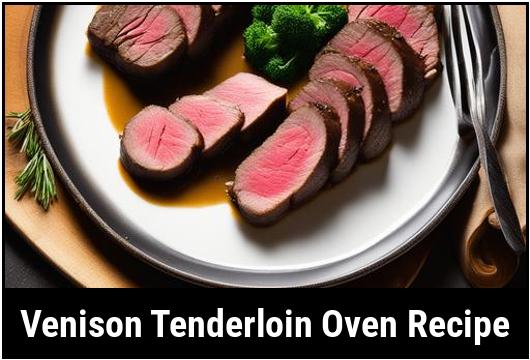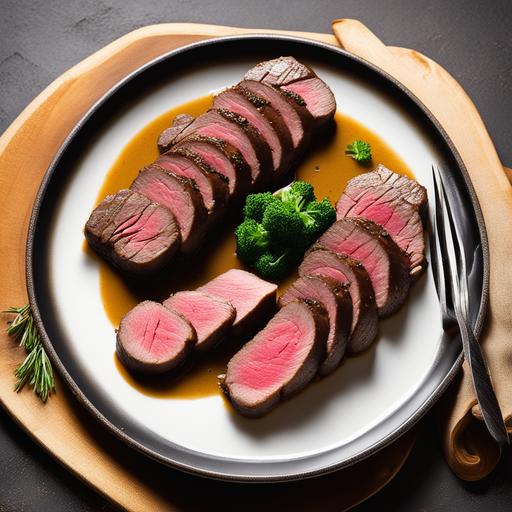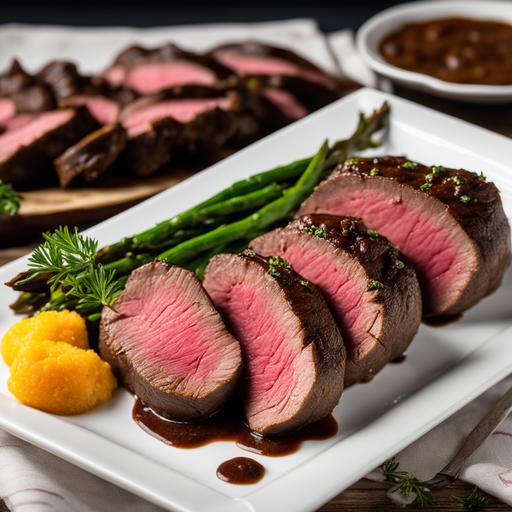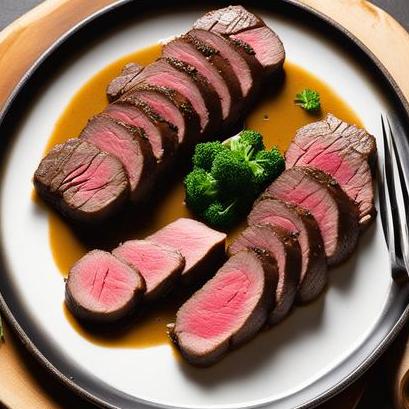
Venison Tenderloin: A Delectable Delight Straight From The Oven
There’s nothing quite like sinking your teeth into a perfectly cooked venison tenderloin. This tender and succulent cut of meat, sourced from deer, offers a unique flavor that is sure to impress even the most discerning taste buds. With its lean yet tender texture, venison tenderloin is a true culinary treasure.
In this comprehensive guide, we will delve deep into the world of venison tenderloin. From the science behind its exceptional qualities to the intricate culinary details required for its preparation, we will explore every aspect of this esteemed dish. Get ready to embark on a culinary journey that will leave you with a newfound appreciation for this delectable meat.
Understanding the Science behind Venison Tenderloin
One of the first steps in mastering the art of cooking venison tenderloin is understanding the science behind it. Venison, being a wild game meat, possesses certain unique characteristics that set it apart from more traditional meats like beef or chicken.
Lean and Nutritious
Venison tenderloin is incredibly lean, making it an excellent choice for health-conscious individuals. With minimal fat marbling, this cut offers a healthier alternative to traditional meats while still delivering a rich and meaty taste.
Tender and Moisture Control
To ensure a tender and juicy result, it’s important to consider moisture control when cooking venison tenderloin. Due to its low fat content, overcooking can easily result in a dry and tough texture. Therefore, employing proper cooking techniques is paramount.
Selecting the Perfect Venison Tenderloin
Before embarking on the culinary adventure of preparing venison tenderloin, it’s essential to know how to select the perfect cut of meat. Follow these guidelines to ensure you’re starting with a high-quality and fresh tenderloin.
-
Choose Reputable Suppliers: Opt for trusted suppliers who source their venison from reliable and sustainable sources. This ensures that you are receiving high-quality meat that adheres to strict safety standards.
-
Look for Bright and Red Meat: Fresh venison tenderloin should have a bright and vibrant red color. Avoid meat that appears discolored, as it may indicate spoilage.
-
Inspect the Texture: Run your fingertips along the surface of the meat. It should feel firm but still yield slightly to touch. Avoid meat that feels overly tough or mushy.
Cleaning and Preparing Venison Tenderloin

Once you’ve selected the perfect venison tenderloin, it’s time to clean and prepare it for cooking. Following these steps ensures that your meat is pristine and ready to be transformed into a culinary masterpiece.
-
Rinse the Meat: Gently rinse the tenderloin under cool running water to remove any surface impurities. Pat it dry with paper towels afterward.
-
Trim Excess Fat and Silverskin: Venison tenderloin, being a lean cut of meat, usually has minimal fat. However, carefully trim any excess fat or silverskin that might still be present. This improves the texture and overall taste.
-
Marinating Options: While marinating isn’t necessary, it can enhance the flavor and tenderness of the meat. Choose a suitable marinade that complements the natural flavors of venison. Let the tenderloin marinate for a few hours or overnight to allow the flavors to penetrate the meat.
Cooking Tips for Venison Tenderloin

Venison tenderloin requires a delicate balance during the cooking process to ensure a mouthwatering outcome. Consider these tips and techniques to achieve the perfect doneness and flavor profile.
-
Searing for Flavor: Start by searing the venison tenderloin in a hot skillet or grill. Searing forms a beautiful crust on the surface, sealing in moisture and enhancing the flavor. Aim for a golden-brown color on all sides.
-
Roasting Temperatures: To achieve an even and succulent result, transfer the seared tenderloin to a preheated oven. Set the oven to a moderate temperature, around 375°F (190°C). This allows for even heat distribution throughout the meat.
-
Use a Meat Thermometer: The key to perfectly cooked venison tenderloin lies in precise temperature control. Use a meat thermometer to monitor the internal temperature. Aim for a medium-rare to medium doneness, around 130°F to 140°F (54°C to 60°C). This ensures a tender and juicy outcome without sacrificing flavor.
-
Resting Period: After removing the tenderloin from the oven, let it rest for a few minutes before slicing. This resting period allows the meat to reabsorb its juices, resulting in a more flavorful and tender final product.
Venison Tenderloin Recipe: An Exquisite Delight

Now that you’re equipped with the knowledge of venison tenderloin’s unique qualities and the techniques required for its preparation, it’s time to dive into a mouthwatering recipe that showcases this exceptional cut.
Ingredients
-
1 to 2 pounds of venison tenderloin
-
Salt and freshly ground black pepper, to taste
-
2 tablespoons of olive oil
-
4 cloves of garlic, minced
-
Fresh herbs (rosemary, thyme, or sage), to taste
-
Optional: additional marinade of choice (e.g., red wine, balsamic vinegar, or soy sauce)
Instructions
-
Preheat your oven to 375°F (190°C).
-
Season the venison tenderloin generously with salt and freshly ground black pepper on all sides.
-
In a skillet over medium-high heat, heat the olive oil until shimmering. Sear the tenderloin for about 2-3 minutes per side, or until a golden-brown crust has formed.
-
Transfer the seared tenderloin to a baking dish or oven-safe skillet.
-
If using herbs, sprinkle them over the tenderloin, along with the minced garlic. If using additional marinade, drizzle it over the meat.
-
Place the baking dish or skillet in the preheated oven and roast for approximately 15-20 minutes, or until the desired internal temperature is reached (medium-rare to medium).
-
Once cooked to perfection, remove the tenderloin from the oven and let it rest for a few minutes before slicing.
-
Slice the venison tenderloin against the grain into medallions and serve with your choice of sides or sauces.
Exploring Variations and Enhancements

Though the above recipe is a classic way to prepare venison tenderloin, there is no shortage of variations and enhancements to explore. These options allow you to tailor the dish to your preferences, experiment with different flavors, and impress your guests with a touch of creativity. Consider the following ideas:
-
Marinades: Experiment with various marinades such as red wine, balsamic vinegar, soy sauce-based marinades, or even fruit juices. Each marinade imparts unique flavors and tenderization properties to the venison.
-
Glazes and Sauces: Elevate the dish by adding a glaze or sauce. Consider a red wine reduction, berry compote, or a tangy mustard-based sauce to enhance the flavors.
-
Spice Rubs: Create a tantalizing crust on the tenderloin by applying spice rubs before searing. Options like cumin, paprika, garlic powder, and dried herbs can add depth and complexity to the dish.
-
Accompaniments: Pair venison tenderloin with complementary sides such as mashed potatoes, roasted vegetables, quinoa, or a refreshing green salad. These vibrant accompaniments provide balance and contrast to the meat’s richness.
Final Thoughts and Doneness Checks
When it comes to cooking venison tenderloin, achieving the right doneness is crucial. The following tips will help you determine the internal temperature and ensure your venison is cooked to perfection:
-
Meat Thermometer: Invest in a reliable meat thermometer to accurately gauge the temperature of the tenderloin. Insert the thermometer into the thickest part of the meat, avoiding contact with bones or excessive fat.
-
Internal Temperature: For medium-rare, aim for an internal temperature of 130°F to 135°F (54°C to 57°C), while medium doneness can be achieved at around 140°F to 145°F (60°C to 63°C). Keep in mind that the temperature will continue to rise slightly during the resting period.
-
Resting Period: Once the venison tenderloin reaches the desired internal temperature, remove it from the oven and let it rest for approximately 5-10 minutes. During this time, the temperature will stabilize, and the meat will become even more tender and juicy.
In conclusion, cooking venison tenderloin is a gratifying experience that rewards both the chef and the diners. The science behind this exotic meat, coupled with meticulous culinary techniques, ensures a sublime and memorable dining experience. With this comprehensive guide at your disposal, you are now equipped to savor the succulent flavors of venison tenderloin straight from your own oven. So, gather your ingredients, don your chef’s hat, and embark on a culinary journey that is nothing short of extraordinary. Happy cooking!
Sources
FAQS On Venison Tenderloin Oven Recipe
What Is Venison Tenderloin, And How Do I Prepare It?
Venison tenderloin is the most tender cut from the deer. To prepare it, you can roast it in the oven with your favorite seasonings.
What Temperature Should I Cook Venison Tenderloin In The Oven, And For How Long?
Preheat your oven to 425°F. Place the tenderloin in a baking dish and cook for 15-20 minutes or until the internal temperature reaches 130°F for medium-rare. Let it rest for 5 minutes before slicing.
How Do I Season Venison Tenderloin For Oven Roasting?
You can keep it simple by seasoning with salt and pepper. You can also add garlic, rosemary, thyme or your preferred herbs and spices. A marinade made with olive oil, soy sauce, and Worcestershire sauce can also enhance the flavor of the meat.
Can I Use The Same Oven Recipe For Frozen Venison Tenderloin?
If your venison tenderloin is frozen, you will need to thaw it first in the refrigerator overnight before cooking in the oven.
What Are Some Side Dishes That Would Pair Well With Venison Tenderloin?
Roasted potatoes or other root vegetables, sautéed mushrooms, a side salad with a vinaigrette dressing, and a glass of red wine would all complement venison tenderloin.


